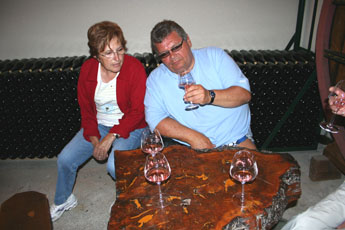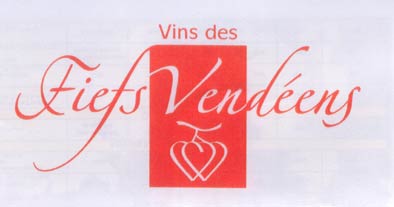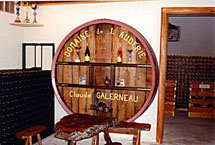| Vendee Information Vendee History Accommodation, Photos, Reviews, Maps, |
Wines of the Vendée
Sud
Vendee.. Haut
Bocage.. Coastal
Region.. Marais
Poitevin.. Marais
Breton.. Bas Bocage.. Plaine.. Marais
Olonne..
Les Fiefs
Vendéens Four wine areas in particular : BREM, MAREUIL, PISSOTTE and VIX ,
were duly recognised by the wine authorities and attributed the AOC (Appellation
original controlee) label of quality.
Today, about a hundred wine
growers established in these well defined areas have launched into a great
venture of producing wine under the logo “Fiefs Vendéens” (vineyards of
Vendée)
Benefiting from more sunshine than the national average, the White,
Rose' and Red wines from these four areas are wines with delicate bouquets with
completely different fragrances. The wines from the Brem area are produced from
two different grape varieties called Groulleau Gris and Chenin, they are limpid
and soft wines with a very often discreet apple aroma. Situated more to the
south east, the small vineyards of Vix and Pissotte produce full-bodied wines,
They are made from the same types of grape varieties as the wines from the other
areas, but to which are they add Sauvignon in the Vix region and An Melon in the
Pissotte region.
To the north of the Vendée there is wine grown that meets
the AOC quality and yet other areas that produce wine in the lower Vin de Pay
and Vin de Table category.
These are the official wines, but those who live in the Vendée
tell of a different breed of wine.
In the late 1900’s France lost most of her
vines to the Phylloxera. The government decided to destroy all of the vines and
re-import new vines back from California and South Africa in the varieties that
originally existed so that they could continue with their traditional wine
production. I'm informed it was at this time that Appelation controlee was
introduced to firstly control the grape varieties that went in each distinct
wine, but secondly to control the amount that was produced, thus keeping the
price up to pay for this work.
The Vendée didn't grow many grapes and it
seems that Phylloxera didn't affect those that tey did grow, and being good
farmers they didn’t destroy what wasn't affected. These vines still exist today
and are the true Bordeaux’s. They are said to be very Fruity and the reds are
dark in colour, so much so that they say the glass turns blue when washed. The
other striking feature is that most of the wines produced from these vines have
an alcohol content of up to 18%.
The stories of these wines that you hear
whispered about in quiet corners say that they are called Vin-Fool; because once
you start drinking them you do not detect the strong alcohol content in them so
you drink more than is good for you.
I recently asked an old farmer about
them, and he told me that there were quite a few different wines.
The two
whites he mentioned were Noah (the myth is that Noah came ashore and planted his
staff, this took root and became a vine). The other was Castell white, so I
presume that there must also be a red. The reds he mentioned were Oberlin and
Jurassian.(I'm not sure of the correct spelling). It seems there is no
rose.
It is said to be illegal to grow and sell these grapes so I'm not sure
where you can get to try them out other than quietly ask the older man in the
small villages, you may be lucky, if
they take a shine to you. As I am no longer able to drink (damage to liver
caused by too much medicine after a back operation) I have little interest in
chasing this one.
There are wines more generally available from locals once
you get to know them, there are the imported vines, still quoted in their number
formed. One I tried a few years ago was Dix Huit Mille (18000),it is a bog
standard Bordeaux wine of about 12%. Again you can’t buy them to my knowledge
but often you will be given the chance to try them.
Pineau Most people will
have heard of Pineau from the Cognac area. It was originally started by a man
from Jersey who came to the Cognac area to produce a fortified wine to compete
with Sherry from Spain and Port from Portugal. He never succeeded in his quest
but the distilled alcohol of the wine, Eau de Vie, become a world beater as the
Brandy we know as Cognac. Pineau uses Eau de Vie to fortify the local wine and
is an excellent drink.
The south Vendée is just in the Congac area in a
region called Bois de Cognac, and the older men are still allowed under permit
to have their unusable alcohol leftovers distilled to make Eau de Vie. With this
Eau de Vie the locals make their Pineau, these vary greatly with many having
additives such as walnuts and cherries added to give a distinct
flavour.
Vendée Pineau. The True Vendée Pineau is not a fortified
wine but a fortified fruit juice, made from one of the old grape varieties, the
moment the juice is extracted the Eau de vie is added to stop the fermentation.
It is kept in oak barrels for the winter before being bottled. I have never
heard of these being available commercially although if you go to a dinner party
with the locals you will often be given a glass as an aperitif. These Pineau's
are exceptionally fruity and the locals claim the finest is made from the Noah
Grape. It seems this method does not work so well with traditional grape
varieties.
Whatever the area, all these wines are cultivated with love by
each grower and the spirit of the country seems to sing in the
bottle.
Return to find more Vendée-wine



In
accordance with the law "and Freedoms" of January 6, 1978, you have the right to
access and rectify information concerning you. If you wish to exercise this
right, please contact
us.
© Copyright Vendee-Guide.co.uk 2009-11
© Copyright Vendee-Guide.co.uk 2009-11